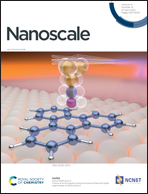Twist-angle-controlled neutral exciton annihilation in WS2 homostructures†
Abstract
Exciton–exciton annihilation (EEA), as typical nonradiative recombination, plays an unpopular role in semiconductors. The nonradiative process significantly reduces the quantum yield of photoluminescence, which substantially inhibits the maximum efficiency of optoelectronic devices. Recently, laser irradiation, introducing defects and applying strain have become effective means to restrain EEA in two-dimensional (2D) transition metal dichalcogenides (TMDCs). However, these methods destroy the atomic structure of 2D materials and limit their practical applications. Fortunately, twisted structures are expected to validly suppress EEA through excellent interface quality. Here, we develop a non-destructive way to control EEA in WS2 homostructures by changing the interlayer twist angle, and systematically study the effect of interlayer twist angle on EEA, using fluorescence lifetime imaging measurement (FLIM) technology. Due to the large moiré potential at a small interlayer twist angle, the diffusion of excitons is hindered, and the EEA rate decreases from 1.01 × 10−1 cm2 s−1 in a 9° twisted WS2 homostructure to 4.26 × 10−2 cm2 s−1 in a 1° twisted WS2 homostructure. The results reveal the important role of the interlayer twist angle and EEA interaction in high photoluminescence quantum yield optoelectronic devices based on TMDC homostructures.



 Please wait while we load your content...
Please wait while we load your content...